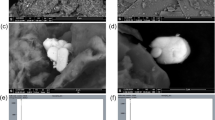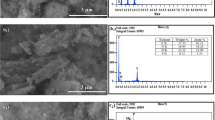Abstract
Pyridine N-oxide and montmorillonite form interlamellar complexes with basal spacings of 14·7 and 21 Å. The former corresponds to a monolayer with a tilted orientation of the pyridine ring; the latter comprises a double layer of molecules between the clay sheets. Infrared spectra show that pyridine N-oxide bonds through the NO group; in the 21 Å complexes it is coordinated to the exchangeable cations through water molecules acting as bridges which themselves are directly coordinated to the cations. In the 14·7 Å complexes a splitting of the ν(NO) band occurs with the more polarizing cations Mg and Ca; the two bands correspond to pyridine N-oxide molecules directly coordinated to the cation and to other molecules coordinated through bridging by water molecules. Cs montmorillonite forms complexes with a basal spacing of approximately 14·7 Å which also shows a splitting of the ν(NO) band.
Résumé
Le N-oxyde de pyridine et la montmorillonite forment des complexes interlamellaires avec des espacements basals de 14,7 et 21 Å. Le premier correspond à une monocouche avec une orientation inclinée du noyau pyridine; le second correspond à une double couche de molécules entre les feuillets d’argile. Les spectres infrarouges montrent que le N-oxyde de pyridine est lié par le groupe NO; dans les complexes à 21 Å, il est coordonné aux cations échangeables par l’intermédiaire de molécules d’eau agissant comme des ponts qui sont eux-mêmes directement coordonnés aux cations. Dans les complexes à 14,7 Å on observe un dédoublement de la bande ν (NO) avec les cations très polarisants Mg et Ca; les deux bandes correspondent à des molécules de N-oxyde de pyridine directement coordonnées aux cations et à d’autres molécules coordonnées par l’intermédiaire des molécules d’eau. La montmorillonite Cs forme des complexes avec un espacement basal de 14,7 Å environ, qui montrent aussi un dédoublement de la bande ν(NO).
Kurzreferat
Pyridin-N-oxide und Montmorillonit bilden Zwischenschicht-Einlagerungskomplexe mit Basisebenenabständen von 14,7 und 21 Å. Ersterer entspricht einer einmolekularen Schicht mit Schrägstellung der Pyridin-Ringe. Letzterer enthält eine Doppelschicht der Moleküle zwischen den Silicatschichten. Infrarotspektren zeigen, daß das Pyridin-N-oxid über die NO-Gruppe gebunden wird. Es ist im 21 Å-Komplex mit den austauschbaren Kationen koordiniert und zwar über Wassermoleküle, die ihrerseits eine direkte Zuordnung zu den Kationen aufweisen. Im 14,7 Å-Komplex tritt mit den stäker polarisierbaren Kationen Mg und Ca eine Aufspaltung der ν(NO)-Bande auf. Die beiden Banden entsprechen Pyridin-N-oxid-Molekülen, die direkt mit dem Kation und solchen, die über Wassermolekülbrücken koordiniert sind. Cs-Montmorillonit bildet Komplexe mit einem Basisebenenabstand von annähend 14,7 Å, die ebenfalls Aufspaltung der ν(NO)-Bande zeigen.
Резюме
N-окисный пиридин и монтмориллонит образуют интерламинарные комплексы с постоянной кристаллической решетки 14,7 и 21 0А. Первый соответствует мономолекулярному слою с наклонной ориентацией пиридинового кольца; последний заключает в себе двойной слой молекул между пластами глины. Инфракрасная область спектра показывает, что N-окисный пиридин связан по группе NO; в комплексах 21 0А он координационно присоединен к катионам посредством молекул воды, образующих мостиковые связи, которые в свою очередь вступают непосредственно в координационную связь с катионами. В комплексе 14,7 0А расщепление полосы ν (NO) происходит с более поляризующими катионами Мg и Са; обе полосы соответствуют молекулам N-окисного пиридина непосредственно координированных с катионом и с остальными молекулами координационно присоединенными мостиковой связью к молекулам воды. Сs монтмориллонит образут комплексы с постоянной кристаллической решетки примерно 14,7 0А, также проявляющей расщепление полосы ν (NO).
Similar content being viewed by others
References
Edwards, D. G., Posner, A. M. and Quirk, J. P. (1965) Repulsion of chloride ions by negatively charged clay surfaces — II. Monovalent cation montmorillonites: Trans. Faraday Soc. 61, 2816–2819.
Farmer, V. C. and Mortland, M. M. (1966) An infrared study of the coordination of pyridine and water to exchangeable cations in montmorillonite and saponite: J. Chem. Soc. A344–351.
Greene-Kelly, R. (1955) Sorption of aromatic organic compounds by montmorillonite—1. Orientation studies: Trans. Faraday Soc. 51, 412–424.
Greenland, D. J., Laby, R. H. and Quirk, J. P. (1962) The adsorption of glycine and its di-, tri- and tetrapeptides by montmorillonite: Trans. Faraday Soc. 58, 829–841.
Hadzi, D. (1965) Infrared spectra of strongly hydrogenbonded systems: Pure Appl. Chem. 11, 435–453.
Hadzi, D. and Kobilarov, N. (1966) Hydrogen bonding in some adducts of oxygen bases with acids—II. Infrared spectra of liquid adducts of carboxylic acids with sulphoxides, phosphine oxides, and other bases: J. Chem. Soc. A439–445.
Kakiuti, T., Kida, S. and Quagliano, J. V. (1963) Metal-ligand, stretching, N-O stretching and C-H out-of-plane bending vibrations of pyridine N-oxide and hexakis (pyridine N-oxide) metal perchlorates: Spectrochim. Acta. 19, 201–211.
Kida, S., Quagliano, J. V., Walmsley, J. A. and Tyree, S. Y. (1963) Infra-red studies of pyridine N-oxide and its Co(II), Ni(II), Cu(II), Zn(II), Al(III), Cr(III), Fe(II), Fe(III), and Sn(IV), complexes in the 3–15μ region: Spectrochim. Acta. 19, 189–199.
Linton, E. P. (1940) The dipole moments of amine oxides: Am. J. Chem. Soc. 62, 1945–1948.
MacEwan, D. M. C. (1948) Complexes of clays with organic compounds. I. Complex formation between montmorillonite and halloysite and certain organic liquids: Trans. Faraday Soc. 44, 349–367.
Ochai, E. (1953) Recent Japanese work on the chemistry of pyridine 1-oxide and related compounds: J. Org. Chem. 18, 534–551.
Parfitt, R. L. and Mortland, M. M. (1968) Ketone adsorption on montmorillonite: Soil Sci. Soc. Am. Proc. 32, 355–363.
Parrish, W. and Mack, M. (1963) Data for X-ray Analysis Vol. 2 3rd Ed. Phillips Technical Library.
Posner, A. M. and Quirk, J. P. (1964) The adsorption of water from concentrated electrolyte solutions by montmorillonite and illite: Proc. Roy. Soc. (Lond.) 278A, 35–56.
Russell, J. D. and Farmer, V. C. (1964) I.R. Spectroscopic study of the dehydration of montmorillonite and saponite: Clay Minerals Bull. 5, 443–464.
Serratosa, J. M. (1966) Infrared analysis of the orientation of pyridine molecules in clay complexes: Clays and Clay Minerals 14, 385–391.
van Olphen, H. (1968) Modification of the clay surface by pyridine-type compounds: J. Colloid Interface Sci. 28, 370–375.
Yariv, S., Russell, J. D. and Farmer, V. C. (1966) Infrared study of the adsorption of benzoic acid and nitrobenzene in montmorillonite: Israel J. Chem. 4, 201–213.
Author information
Authors and Affiliations
Rights and permissions
About this article
Cite this article
Olejnik, S., Posner, A.M. & Quirk, J.P. Adsorption of Pyridine N-Oxide onto Montmorillonite. Clays Clay Miner. 21, 191–198 (1973). https://doi.org/10.1346/CCMN.1973.0210308
Received:
Published:
Issue Date:
DOI: https://doi.org/10.1346/CCMN.1973.0210308




